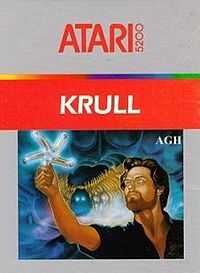Krull (video game)
| Krull | |
|---|---|
 Cartridge art for the unproduced Atari 5200 version of the game. | |
| Developer(s) | Atari |
| Publisher(s) | Atari |
| Distributor(s) | Atari |
| Designer(s) | Dave Staugas (arcade version designed by Matt Householder, Chris Krubel, and Jeff Lee.) |
| Platform(s) | Arcade game, Atari 2600 |
| Release date(s) |
|
| Genre(s) | Adventure |
| Mode(s) | Single player |
| Distribution | 16Kb ROM cartridge |
Krull is a video game based on the film of the same name. The first Krull adaptation was a 1983 arcade game manufactured by D. Gottlieb & Co..[1] A home adaptation similar to the arcade version was planned for the Atari 5200, but poor sales of that console prompted the decision to release the game on the Atari 2600 instead.[2] A pinball version was also developed but not put into production.
Atari version
Gameplay
The game, designed by Dave Staugas, mostly follows the plot of the movie, and takes place on four separate screens. In the first level, the player, as Colwyn, starts at his wedding to Lyssa, which is interrupted by the extraterrestrial Slayers. The game continues to generate new Slayers for the player to fight until he is overwhelmed and Lyssa is abducted to the Black Fortress.
The player then traverses the Iron Desert on a Fire Mare, stocking up on Colwyn's magical throwing weapon, the Glaive (in the film there is only one), by pressing the button each time the horse rides over one.
The next level takes place in the lair of the Widow of the Web. The player is required to jump between moving threads of web, towards the widow at the top of the screen, while avoiding a giant spider. After completing this task, the widow reveals the location of the Black Fortress, and the player again rides a Fire Mare through the Iron Desert to reach it. If the player does not arrive at the correct time of day, according to a timer at the top of the screen, he loses a life and must return to the Widow to find out the Fortress's new location.
At the Black Fortress, the player must penetrate the barrier surrounding Lyssa with the Glaive (of which the player has a limited number), while the Beast attempts to block the player's shots and hit him with fireballs. If the Glaive hits the Beast or is not caught on the rebound by the player, that Glaive is lost. If all of the player's Glaives are lost, he must return to the Widow of the Web level, discover the new location of the Black Fortress, and traverse the Iron Desert again.
If the player manages to break through the barrier surrounding Lyssa, she turns into a fireball the player can throw at the Beast. If the fireball hits, the player wins, and the game starts over at a higher level of difficulty.[2]
Arcade version
Released in 1984, the Krull arcade game was programmed by Matt Householder and Chris Krubel. The graphics were done by Jeff Lee (one of the creators of Q*bert), the sound by David Thiel. The cabinet art was created by Terry Doerzaph. About 2500 units were produced.[citation needed]
Gameplay
First event: Pickup the pieces (five) of your weapon... the glaive, avoid all boulders.
Second event: Shoot the slayers, rescue your army (very much like Robotron).
Third event: Pick up your army, lead it to the hexagon.
Fourth event: Break down the front wall of the hexagon... when it is black.
Fifth event: Save Princess Lyssa, avoid the beast, avoid his fireballs.
Pinball game
In addition to the arcade game, D. Gottlieb & Co. also initially planned a pinball version of the game, but for reasons of cost the machine was never put into production.[3] However, ten complete units were manufactured as professional samples, making these machines extremely rare and valuable to modern collectors.[4]
Response
The Atari version of the game was generally well received and is today considered one of the better early film-to-game adaptations, with some of the best graphics and sound featured on the system.[5]
References
- ↑ The Krull arcade game
- ↑ 2.0 2.1 Atari Protos history and review
- ↑ Krull entry in the International Pinball Database
- ↑ Mr. Pinball Krull page
- ↑ Krull review in the Atari Times